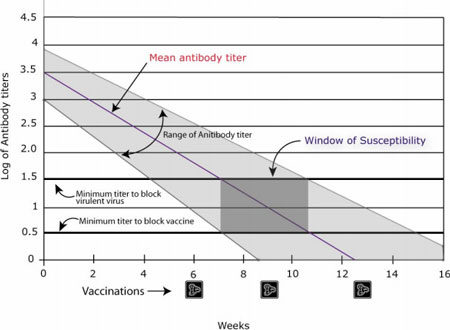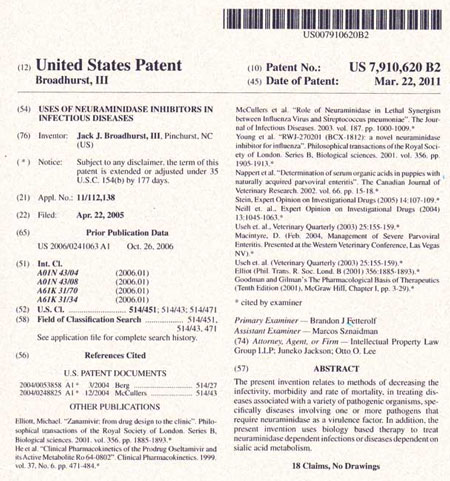What is Parvovirus?
Introduction
Parvovirus is a viral disease of dogs. It affects puppies much more frequently
than it affects adult dogs. The virus likes to grow in rapidly dividing cells.
The intestinal lining has the biggest concentration of rapidly dividing cells in a puppy's body.
The virus attacks and kills these cells, causing diarrhea (often bloody), depression and
suppression of white blood cells -- which come from another group of rapidly dividing cells. In
very young puppies it can infect the heart muscle and lead to "sudden" death.
Parvovirus Vaccination
Parvovirus is probably the most common viral illness of dogs at the present time.
It is much more common in puppies than it is in adult dogs. It can be very hard to
successfully vaccinate a puppy for this disease because the antibody protection the
puppy acquires from its mother can interfere with vaccination. Many vets recommend
vaccinating puppies every three to four weeks for this virus starting at 6 weeks of
age and continuing until they are at least 16 weeks of age and preferably 20 weeks of age.
It is possible that this vaccine confers lifelong immunity once it does work but most
veterinarians continue to recommend yearly vaccination for it. It seems prudent to
at least get the vaccination at one year of age. Since it is combined with the other
vaccines it is often easier just to give it yearly with them.
Our revised vaccination schedule is as follows:
At exactly 5 weeks: NeoPar (Modified Live Virus) - from RevivalAnimal.com
At exactly 6 weeks: Intervet Progard 5 - from RevivalAnimal.com
At exactly 9 weeks: Intervet Progard 5 - from RevivalAnimal.com
At exactly 12 weeks: Intervet Progard 5 - from RevivalAnimal.com
How can a vaccinated puppy get Parvo? When a puppy nurses off of its mother is ingests
Colostrum
which contains the mother's antibodies for the Parvo virus (assuming that the mother was vaccinated).
This oral transfer of immunity can occur because the newborn's stomach is porous. These
antibodies protect the puppy for 4-18 weeks; there are variables that affect this duration.
Maternal anti-bodies "wear off" from 4-18(20) weeks. When one vaccinates
a young puppy, the hope is that the puppy develops antibodies against the Parvo virus.
However, sometimes the antibodies from the mother, fight off the vaccination and the puppy
never develops its own antibodies. Unfortunately, as the mother's antibodies fade,
so does the protection against the Parvo virus. So there is always a suceptibility window where
the mother's immunity stops and the puppy's immunity begins. Puppies can still contract the Parvo virus
in this suceptibility window. This is unfortunate but true. We attempt to mitigate this risk
by re-vaccinating at regular intervals.
 Everything about Parvo
Everything about Parvo
What are the symptoms of Parvo?
"Parvo" is a virus that attacks the lining of the digestive system. It causes dogs and puppies to not be able to absorb nutrients or liquids. Puppies are especially prone to it because they have an immature immune system. When dogs and puppies contract parvo, they often have diarrhea, vomiting and lethargy. Usually they stop eating and develop a bloody, foul-smelling, liquid stool.
Symptoms usually begin with a high fever, lethargy, depression, and loss of appetite. Secondary symptoms appear as severe gastrointestinal distress, such as vomiting and bloody diarrhea. In many cases, dehydration, shock, and death follow.
Parvovirus is characterized by severe, bloody diarrhea and vomiting, high fever and lethargy. The diarrhea is particularly foul smelling and is sometimes yellow in color. Parvo can also attack a dog's heart causing congestive heart failure. This complication can occur months or years after an apparent recovery from the intestinal form of the disease. Puppies who survive parvo infection usually remain somewhat un-healthy and weak for life.
How is Parvo transmitted?
Canine parvovirus is carried by dogs. Adult dogs may be infected carriers without showing any clinical signs. Dogs with the typical diarrhea that parvovirus causes shed the virus as well. It can last a long time in the environment, perhaps as long as 9 months or longer.
Generally, it takes 7-10 days from the time of exposure for dogs and puppies to start showing symptoms and to test positive for parvo.
Parvo is highly contagious to unprotected dogs, and the virus can remain infectious in ground contaminated with fecal material for five months or more if conditions are favorable. Extremely hardy, most disinfectants cannot kill the virus, however chlorine bleach is the most effective and inexpensive agent that works, and is commonly used by veterinarians.
The ease with which infection with Parvo can occur in any unvaccinated dog must be stressed. The virus is extremely hardy in the environment. Withstanding wide temperature fluctuations and most cleaning agents. Parvo can be brought home to your dog on shoes, hands and even car tires. It can live for many months outside the animal. Any areas that are thought to be contaminated with parvo should be thoroughly washed with chlorine bleach diluted 1 ounce per quart of water.
Dogs and puppies can contract parvo even if they never leave their yards. Parvo virus, despite what you might hear, is NOT an airborne virus. It is excreted in the feces of infected dogs, and if someone -- human, dog, bird, etc. -- steps in (or otherwise comes in contact with) the excrement, the possibility for contamination is great. Some people speculate that birds invading a dog's food dish can deposit the parvovirus there. If you think you may have come in contact with parvovirus, a strong solution of bleach and water does kill the virus, so you can wash your shoes and clothes, even your hands with it, to reduce the risk of infecting your dog.
Rest assured that parvovirus is specific to dogs alone and cannot be transmitted to humans or other pets of a different species, such as cats.
Does Tamiflu work to Treat Parvo? - YES IT DOES! If your vet does not agree, find another vet!
Tamiflu: Oseltamivir is one of two commercially available sources of a neuraminidase
inhibitor that has been used successfully in treating infectious parvoenteritis.
Neuraminidase: An enzyme that is produced by both bacteria and viruses. It is
considered a virulence factor in viral and bacterial infections that require neuraminidase
to remove biological barriers that protect the host.
Super infections: Any infection that requires both a virus and bacteria to produce an
infection that is more pathogenic than either infectious agent can produce alone.
Veterinary examples: canine and feline Parvo, canine kennel cough and influenza, feline
URI, parvoenteritis in raccoons, and bloody scowls in deer.
The use of Tamiflu in canine, feline, and raccoon parvoenteritis: The success of using a
neuraminidase inhibitor in treating canine and feline Parvo is due to the suppression the
production of bacterial neuraminidase, and has no effect on the Parvovirus' ability to
replicate. Puppies can still develop myocarditis and CHF...kittens can still develop
cerebellar hypoplasia...the patient's feces will still contain the viral antigen even while
the animal is recovering. Tamiflu does not interfere with the replication of the
Parvovirus, and as a result, no mutant or resistant strains of the Parvovirus will be created
from the use of Tamiflu.
Tamiflu should never be used to treat any animal that does not test (+) using the fecal
antigen test. All of the guidelines for using Tamiflu have been developed in cases that
have had a (+) fecal Parvo test.
Dose: 1mg/lb that dose given every 12 hours for 10 consecutive treatments...requires a
(+) fecal antigen test.... There is a direct relationship between clinical response and the
time treatment is started...Tamiflu should be given w/in 48 hrs of onset of clinical
signs... if no response after the first dose...double to 2mg/lb for the second, third dose, etc.
Specific Breeds of Dogs: Dobies, Rotties, Retrievers, Pit Bulldogs, and Alaskan sled
dogs...all require at least 2mg/lb as the starting dose as these breeds respond poorly to
Parvo infections...
As a preventive: Animals have been exposed, but are not currently showing any clinical
signs should be given 1mg/lb once a day for 5 days...if these animals develop one
or more clinical signs (vomiting/bloody diarrhea/anorexia)...treatment should be changed so
that they are given 1mg/lb every 12 hr for a total of 10 treatments.
Animals requiring IV support: Animals sick enough to require IV support
(fluids/antibiotics/antiemetics) respond poorly to Tamiflu. Their clinical condition is the
result of a damaged GI tract with the introduction of GI bacteria and toxins beyond
Tamiflu's ability to protect the patient. If used, Tamiflu can be started at 2mg/lb and the
dose adjusted according to the patient's response every 12 hours.
Animals that vomit after being given oral Tamiflu: These patients can be given the same
dose as an enema. You can also divide the contents of a 75mg capsule into lines and mix
the appropriate amount into pancake syrup or honey and place under the tongue or in the
lip fold.
One 75 mg pill will do 10 doses for a seven and a half lb. puppy, doses at 1mg/lb. Divide accordingly.
After making "lines" (use a knife or razor blade to divide) of the Tamiflu on a plate or smooth
hard surface, for a single dose then mix with a dab of peanut butter (or maple syrup) in a
small cup and place mixture on upper palate of mouth towards the back. If showing severe
symptoms add an antibiotic also, Metronidazole or amoxicillin orally.
ALSO limit fluids, pre-dose with Pepto (pediatric you want one without aspirin)
to stop up loose stools and increase absorption in GI tract. In severe cases an anti-emetic
and sub q fluids might be necessary. If dog foams at the mouth and vomits peanut butter mixture,
switch to maple syrup or dose by enema. Use the Pepto (1/2 caplet or two to three cc's liquid)
about 1/2 hour before Tamiflu if you suspect anything passing too quickly.
Tamiflu Products: There is a suspension that you add 23 cc of water to get 25cc of
12mg/cc. There is also a flat of ten 75 mg capsules.
To use capsules to treat a 5 lb puppy: Mix the contents of 1 capsule into 10 cc of a liquid
diet like Canine Rebound...this will create a 10cc suspension with a concentration of
7.5mg/cc....Refrigerate and shake well and give 1cc q. 12 hrs x 10 treatments.... do not
mix capsules with water as this water suspension is very bitter and can cause the patient
to vomit. One can also use liquid VAL or similar vitamin prep.
To use the suspension (12mg/cc) to treat a 5 lb puppy: Shake well and give the puppy
0.5cc of the suspension q. 12 hrs x 10 treatments. Refrigerate the suspension after adding
water and between treatments.
In the event that the commercially manufactured Tamiflu Oral Suspension is not available,
the pharmacist may compound a suspension (15 mg/mL) from Tamiflu (oseltamivir phosphate)
Capsules 75 mg using either of two vehicles: Cherry Syrup (Humco®)* or Ora-Sweet® SF (sugar-free).
Refrigeration: Stable for 5 weeks (35 days) when stored in a refrigerator at
2° to 8°C (36° to 46°F). Room Temperature: Stable for five days (5 days) when stored
at room temperature, 25°C (77°F). Note: The storage conditions are based on stability
studies of compounded oral suspensions, using the above mentioned vehicles, which were
placed in amber glass and amber polyethyleneterephthalate (PET) bottles. Stability
studies have not been conducted with other vehicles or bottle types.
Tamiflu and FDA: On March 20, 2006, the FDA banned the use of Tamiflu and other
neuraminidase inhibitors in treating chickens, ducks, turkeys and other birds...goes into
effect in June 2006.... you can still use Tamiflu in dogs, cats, and raccoons.
In the emergency clinics or private clinics that are presented with cases whose disease
course is unknown or have exceeded the 48 hrs time-frame: The professional staff should
make the client aware of the poor response to Tamiflu due to the high levels of bacterial
neuraminidase currently present in the patient's GI tract, and the presence of GI
pathology created prior to presentation. Tamiflu will only prevent future pathology, and
cannot reverse any pathology created prior to treatment.
Treating Parvo requires the same mental process used in treating Diabetes Mellitus.... The
DVM begins with a standard initial dose of Tamiflu or insulin and then uses professional
judgment to adjust the following doses required to get a clinical response.
In an uncomplicated case, presented within 48 hrs. of the onset of clinical signs, one
should see no vomiting after the first dose...no diarrhea after the 2nd...and alert/eating
after the 3rd dose. If there is no clinical response after the 3rd dose...
you have either started using Tamiflu too late, have a secondary medical problem that needs to be
addressed, or have the wrong diagnosis.
In summary, the introduction of the concept of using a neuraminidase inhibitor to treat
canine, feline and raccoon Parvoenteritis, has opened many new doors into the
understanding of the pathobiology and treatment of this disease. Prior to April 24, 2004,
Parvovirus was thought of as viral enteritis. Based on this concept, vaccines were
developed to help prevent or reduce the severity of the clinical disease.
Once the disease was diagnosed, treatment protocols were all designed to address the
various end products produced during the disease. The presence of vomiting and/or
diarrhea usually dictated that most drugs were given intravenously. Animals that are
hospitalized usually remain 3-7 days with unpredictable prognosis. This is because none
of the treatments address the core problem of excessive GI bacterial neuraminidase.
Drugs are given to address all of the various reactions such as: vomiting, endotoxic
shock, pain, bacterial septicemia, GI mucosal ulcerations and general organ failure. This
approach requires many drugs and man-hours to treat the multiple pathological processes
associated with viral Parvoenteritis.
With the introduction of using a neuraminidase inhibitor (Tamiflu), we established that
Parvoenteritis is not a viral enteritis, but a super infection that requires the presence of
bacterial neuraminidase. When a neuraminidase inhibitor is use under the strict guidelines
developed since April 24, 2004, the disease is not allowed to develop into the clinical
disease currently known as viral Parvoenteritis. The commensal bacteria do not
transform into pathologic bacteria, and the patient's disease is not allowed to progress as
described in the veterinary literature. In order to achieve this reversal, there has to be a
definitive diagnosis and the neuraminidase has to be given according to established
guidelines.
Please keep in mind that any recommendations given in this article are not FDA
approved. They are offered to help educate and guide those anticipating using
Oseltamivir therapy in the future. Roadrunner Pharmacy is currently in the process of
acquiring Oseltamivir powder to be compounded into the various formulations and
concentrations requested by our clients.
To insure the continual gathering of clinical data, please contact Jack J. Broadhurst,
DVM at doccat@aol.com or fax at 910-295-2265. There is a clinical trial form that if
filled out and returned, will insure a central point for clinical results to be stored. He can
also be contacted at 910-295-2287.
Jack J. Broadhurst, DVM
The Cat Health Clinic
2212 Midland Road
Pinehurst, NC 28374
Tamiflu Information Source
If your vet thinks that this is not an approved treatment, refer him/her to the patent office.

How is Parvo treated?
Without intense treatment, the victims of parvo die of dehydration. The traditional treatment generally consists of IV
or sub-cutaneous fluids and antibiotics. There is no cure. One view held by Veterinarians can only treat the symptoms
palliatively, and try to keep the dog alive by preventing dehydration and loss of proteins. I personally believe that
using Tamilflu drastically improves the puppies chances for survival; (explanation given above). I have
personally seen puppies recover in one day! As there is no cure for any virus, treatment for parvo is
mostly that of supporting the different systems
in the body during the course of the disease. This includes giving fluids, regulating electrolyte
levels, controlling body temperature and giving blood transfusions when necessary.
Dogs who have survived parvo can get it again. In the case of some puppies, a puppy testing
negative for Parvo one day could succumb to the virus within a matter of days. It strikes fast
and without mercy. Dr. Cathy Priddle has warned that sulfa drugs have been known to cause
dehydration in dogs, suggesting that animals infected with parvovirus should not be given sulfa drugs.
You may also consult a homeopathic or naturopathic veterinarian for alternative
Parvo treatments. There are some natural and homeopathic treatments for Parvo on the
retail market. Amber Technology offers Parvaid, an all natural herbal formula that the
manufacturer claims has helped some animals overcome Parvo.
The use of Tamiflu in canine, feline, and raccoon parvoenteritis: The success of using a
neuraminidase inhibitor in treating canine and feline Parvo is due to the suppression the
production of bacterial neuraminidase, and has no effect on the Parvovirus' ability to
replicate.
Your Veterinarian Clinic has the Parvo virus!
All veterinarian offices/clinics contain the Parvo virus. Where do people bring Parvo positive puppies? To the vet!
Just consider the following: Customers bring in puppies infected with
the Parvo virus. The virus is likely on the customers hands, clothing, shoes, and all over the puppy and its fur.
Now consider all of the surfaces that the customer comes in contact with: the door knob, the floor, the light switch, pen,
a credit card machine,
and the chairs in the waiting room, etc. The virus remains intact for months. Does the vet really sterilize
every possible surface from the parking lot to the examination rooms? There is no way to avoid
the spread of this disease between customers.
The vet patient prior to you might have been a Parvo puppy. All vets will claim: "There is no Parvo Here!".
They cannot realistically make that claim... Please be careful.
Will my dog die if he gets Parvo?
This is a very serious disease. Some puppies infected with parvovirus will die despite prompt and adequate treatment. While no extremely accurate statistics are available, a good guess is probably that 80% of puppies treated for parvovirus will live. Without treatment, probably 80% or more of the infected puppies would die.
Due to the high death rate, parvovirus gets a lot of free publicity. Many people just assume that any case of diarrhea in a dog is from parvovirus. This is not true. There are a lot of other diseases and disorders that lead to diarrhea. If you have a puppy, don't take any chances. Have your puppy examined by your vet if diarrhea is a factor in any disease. It is better to be safe than to be sorry.
If your dog becomes infected with parvovirus, he has about a 50-50 chance of survival. If he makes it through the first three to four days, he will usually make a rapid recovery, and be back on his feet within a week. It is vital, however, that he receives supportive therapy immediately. It must be stressed that this is not a bad case of doggy flu; without medical treatment, most puppies die.
How do I prevent the spread of Parvo?
The surest way to avoid parvo infection in your dog is to adhere to the recommended vaccination schedule which begins when puppies are 6-8 weeks of age. Puppies should not be allowed to socialize with other dogs or frequent areas where other dogs have been until 2 weeks after they have had their last vaccination. Immunization for parvo is usually included in your dog's distemper vaccine. This shot gives protection against several potentially fatal canine diseases all at the same time.
If your pet becomes infected, please keep in mind that dogs with parvo shed the virus in their feces and are extremely contagious to other dogs. Follow these recommendations to help prevent the spread of this disease.
-
Keep the infected dog isolated from all other dogs for at least one month after full recovery.
-
Clean up all the dog's stools in your yard.
-
Use a 1:30 ratio of chlorine bleach and water to clean food and water bowls (4 oz. in 1 gallon of water). Wash any bedding the dog has been in contact with in this same bleach solution and hot water. You should also try to disinfect any other areas that the dog has been, like linoleum, concrete kennels, crates, etc.
-
If you have any other dogs that are two years old or younger, or who have never been vaccinated for parvo, please bring them in for a booster as soon as possible.
-
Be sure to feed your dog a bland diet, such as Canine Prescription i/d, until he is fully recovered. When switching back to his normal diet, mix the regular food with the i/d for 2-3 days to help your pet gradually adjust to the change.
What If I've got Parvo in my home?
If you have had parvo in your home, use a strong bleach/water solution to kill it. Soak the yard with it -- better to kill the grass than your next dog! Be careful using it on carpets and fabrics, though. Parvo can live up to 6 months or so in your home or yard. Before you bring home another dog, be sure it has a strong immunity to parvo. You can have a veterinarian draw blood and run a titre to find out how well your prospective dog will fare in a parvo-infected environment. Adult dogs generally have a higher resistance than puppies do, but they need to be kept current on their vaccines. If in doubt, have your vet do the titre.
Copy Link: What is the Canine Parvo Virus?


















